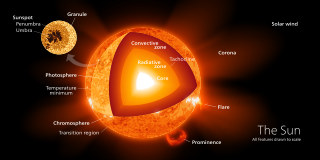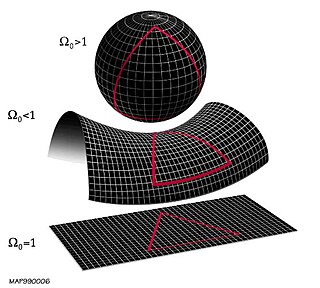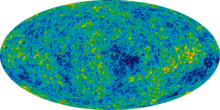Energy density in the expanding universe
If the universe is expanding adiabatically then it will satisfy the first law of thermodynamics:

where  is the total heat which is assumed to be constant,
is the total heat which is assumed to be constant,  is the internal energy of the matter and radiation in the universe,
is the internal energy of the matter and radiation in the universe,  is the pressure and
is the pressure and  the volume.
the volume.
One then finds an equation for the energy density  , and so
, and so

where in the last equality we used the fact that the total volume of the universe is proportional to  ,
,  being the scale factor of the universe.
being the scale factor of the universe.
In fact this is a wrong derivation because it assumes that the pressure is doing work as  increases. However, in the average universe, the pressure is the same everywhere, and thus there is no under-pressure region against which the pressure can do work. The above equation can be directly obtained from the equations of motion governing the Friedmann-Lemaître-Robertson-Walker metric: by dividing the equation above with
increases. However, in the average universe, the pressure is the same everywhere, and thus there is no under-pressure region against which the pressure can do work. The above equation can be directly obtained from the equations of motion governing the Friedmann-Lemaître-Robertson-Walker metric: by dividing the equation above with  and identifying
and identifying  (the energy density), we get one of the FLRW equations of motions.
(the energy density), we get one of the FLRW equations of motions.
In the comoving coordinates,  is equal to the mass density
is equal to the mass density  . For radiation,
. For radiation,  whereas for matter
whereas for matter  and the pressure can be neglected. Thus we get:
and the pressure can be neglected. Thus we get:
For radiation  thus
thus  is proportional to
is proportional to 
For matter  thus
thus  is proportional to
is proportional to 
This can be understood as follows: For matter, the energy density is equal (in our approximation) to the rest mass density. This is inversely proportional to the volume, and is therefore proportional to  . For radiation, the energy density depends on the temperature
. For radiation, the energy density depends on the temperature  as well, and is therefore proportional to
as well, and is therefore proportional to  . As the universe expands it cools down, so
. As the universe expands it cools down, so  depends on
depends on  as well. In fact, since the energy of a relativistic particle is inversely proportional to its wavelength, which is proportional to
as well. In fact, since the energy of a relativistic particle is inversely proportional to its wavelength, which is proportional to  , the energy density of the radiation must be proportional to
, the energy density of the radiation must be proportional to  .
.
From this discussion it is also obvious that the temperature of radiation is inversely proportional to the scale factor  .
.
Rate of expansion of the universe
Plugging this information to the Friedmann-Lemaître-Robertson-Walker equations of motion and neglecting both the cosmological constant  and the curvature parameter
and the curvature parameter  , which is justified for the early universe (
, which is justified for the early universe ( ), one gets the following equation:
), one gets the following equation:

 is the energy density, and one finds the following behavior:
is the energy density, and one finds the following behavior:
- In a radiation-dominated universe:

- In a matter-dominated universe:

One can further show that the universe was radiation-dominated as long as the energy density was of the order of 10 eV to the fourth, or higher. Since the energy density keeps going down, this was no longer true when the universe was 70,000 years old, when it became matter dominant.
In the universe today, matter is mainly in forms of galaxies and dark matter, while the radiation is the cosmic microwave background radiation, the cosmic neutrino background (if the neutrino rest mass is high enough then the latter is formally matter), and finally, mostly in the form of dark energy.
Dark energy and cosmic inflation
Dark energy is a hypothetical form of energy that permeates all of space and its negative pressure coincides with an acceleration in the expansion of the universe. Positive pressure coincides with a deceleration as does the gravity of energy and mass. There is no known cause and effect in fundamental physics, so it is not assumed the pressures or gravity "cause" a reduction or acceleration in the expansion of the universe, nor vice versa. For example, the energy in the gravitional field of the universe that coincides with its expansion is equal and opposite to the mass energy of the universe and it is not assumed (and the equations do not indicate) that the expansion created the positive mass energy and negative gravitational energy, nor vice versa.
According to the equation above,

Thus the more negative the pressure is, the less the energy density reduces as the universe expands. In other words, Dark energy dilutes less than any other form of energy, and will therefore eventually dominate the universe, as all other energy densities gets diluted faster with the expansion of the universe.
In fact, if the dark energy is created by a cosmological constant or a constant scalar field, then its pressure is minus its energy density  , and therefore its energy density remains constant (as is expected by definition).
, and therefore its energy density remains constant (as is expected by definition).
Dark energy is usually assumed to be the Casimir energy of the vacuum, with possible contributions from the energy density of scalar fields which has a non-zero value at the vacuum. It may be that this field can decay at some time in the distant future, leading to a new vacuum state, different than the one we are living in. This is a phase transition, where the dark energy is reduced and huge amounts of energy in conventional forms (i.e. particles) are produced.
Such a series of events is in fact thought to have already occurred in the early universe, where first a cosmological constant much larger than the present one came to dominate the universe, bringing about cosmic inflation. At the end of this epoch, a phase transition occurred where the cosmological constant was reduced to its present value and huge amounts of energy were produced, from which all the radiation and matter of the early universe came about.

The accelerating expansion of the universe is the observation that the expansion of the universe is such that the velocity at which a distant galaxy is receding from the observer is continuously increasing with time.
In physics, quintessence is a hypothetical form of dark energy, more precisely a scalar field, postulated as an explanation of the observation of an accelerating rate of expansion of the universe. The first example of this scenario was proposed by Ratra and Peebles (1988). The concept was expanded to more general types of time-varying dark energy and the term "quintessence" was first introduced in a paper by Robert R. Caldwell, Rahul Dave and Paul Steinhardt. It has been proposed by some physicists to be a fifth fundamental force. Quintessence differs from the cosmological constant explanation of dark energy in that it is dynamic; that is, it changes over time, unlike the cosmological constant which, by definition, does not change. Quintessence can be either attractive or repulsive depending on the ratio of its kinetic and potential energy. Those working with this postulate believe that quintessence became repulsive about ten billion years ago, about 3.5 billion years after the Big Bang.

Hubble's law, also known as the Hubble–Lemaître law, is the observation in physical cosmology that:
- Objects observed in deep space—extragalactic space, 10 megaparsecs (Mpc) or more—are found to have a redshift, interpreted as a relative velocity away from Earth;
- This Doppler shift-measured velocity of various galaxies receding from the Earth is approximately proportional to their distance from the Earth for galaxies up to a few hundred megaparsecs away.
In fluid mechanics, a fluid is said to be in hydrostatic equilibrium or hydrostatic balance when it is at rest, or when the flow velocity for each parcel of fluid is constant over time. This occurs when external forces such as gravity are balanced by a pressure-gradient force. For instance, the pressure-gradient force prevents gravity from collapsing Earth's atmosphere into a thin, dense shell, whereas gravity prevents the pressure gradient force from diffusing the atmosphere into space.

An ideal gas is a theoretical gas composed of many randomly moving point particles whose only interactions are perfectly elastic collisions. The ideal gas concept is useful because it obeys the ideal gas law, a simplified equation of state, and is amenable to analysis under statistical mechanics.
Vacuum energy is an underlying background energy that exists in space throughout the entire Universe. This behavior is codified in Heisenberg's energy–time uncertainty principle. Still, the exact effect of such fleeting bits of energy is difficult to quantify. The vacuum energy is a special case of zero-point energy that relates to the quantum vacuum.

The Friedmann–Lemaître–Robertson–Walker (FLRW) metric is an exact solution of Einstein's field equations of general relativity; it describes a homogeneous, isotropic, expanding universe that is path-connected, but not necessarily simply connected. The general form of the metric follows from the geometric properties of homogeneity and isotropy; Einstein's field equations are only needed to derive the scale factor of the universe as a function of time. Depending on geographical or historical preferences, the set of the four scientists – Alexander Friedmann, Georges Lemaître, Howard P. Robertson and Arthur Geoffrey Walker – are customarily grouped as Friedmann or Friedmann–Robertson–Walker (FRW) or Robertson–Walker (RW) or Friedmann–Lemaître (FL). This model is sometimes called the Standard Model of modern cosmology, although such a description is also associated with the further developed Lambda-CDM model. The FLRW model was developed independently by the named authors in the 1920s and 1930s.

In thermodynamics, the Onsager reciprocal relations express the equality of certain ratios between flows and forces in thermodynamic systems out of equilibrium, but where a notion of local equilibrium exists.
The relative expansion of the universe is parametrized by a dimensionless scale factor. Also known as the cosmic scale factor or sometimes the Robertson Walker scale factor, this is a key parameter of the Friedmann equations.

The ΛCDM or Lambda-CDM model is a parametrization of the Big Bang cosmological model in which the universe contains three major components: first, a cosmological constant denoted by Lambda and associated with dark energy; second, the postulated cold dark matter ; and third, ordinary matter. It is frequently referred to as the standard model of Big Bang cosmology because it is the simplest model that provides a reasonably good account of the following properties of the cosmos:

Stellar structure models describe the internal structure of a star in detail and make predictions about the luminosity, the color and the future evolution of the star. Different classes and ages of stars have different internal structures, reflecting their elemental makeup and energy transport mechanisms.

The flatness problem is a cosmological fine-tuning problem within the Big Bang model of the universe. Such problems arise from the observation that some of the initial conditions of the universe appear to be fine-tuned to very 'special' values, and that small deviations from these values would have extreme effects on the appearance of the universe at the current time.

The Friedmann equations are a set of equations in physical cosmology that govern the expansion of space in homogeneous and isotropic models of the universe within the context of general relativity. They were first derived by Alexander Friedmann in 1922 from Einstein's field equations of gravitation for the Friedmann–Lemaître–Robertson–Walker metric and a perfect fluid with a given mass density and pressure . The equations for negative spatial curvature were given by Friedmann in 1924.

A radiation zone, or radiative region is a layer of a star's interior where energy is primarily transported toward the exterior by means of radiative diffusion and thermal conduction, rather than by convection. Energy travels through the radiation zone in the form of electromagnetic radiation as photons.

In cosmology, the equation of state of a perfect fluid is characterized by a dimensionless number , equal to the ratio of its pressure to its energy density :

In physical cosmology, structure formation is the formation of galaxies, galaxy clusters and larger structures from small early density fluctuations. The universe, as is now known from observations of the cosmic microwave background radiation, began in a hot, dense, nearly uniform state approximately 13.8 billion years ago. However, looking in the sky today, we see structures on all scales, from stars and planets to galaxies and, on still larger scales, galaxy clusters and sheet-like structures of galaxies separated by enormous voids containing few galaxies. Structure formation attempts to model how these structures formed by gravitational instability of small early density ripples.
In relativistic classical field theories of gravitation, particularly general relativity, an energy condition is one of various alternative conditions which can be applied to the matter content of the theory, when it is either not possible or desirable to specify this content explicitly. The hope is then that any reasonable matter theory will satisfy this condition or at least will preserve the condition if it is satisfied by the starting conditions.

The deceleration parameter in cosmology is a dimensionless measure of the cosmic acceleration of the expansion of space in a Friedmann–Lemaître–Robertson–Walker universe. It is defined by:

In physical cosmology and astronomy, dark energy is an unknown form of energy which is hypothesized to permeate all of space, tending to accelerate the expansion of the universe. Dark energy is the most accepted hypothesis to explain the observations since the 1990s indicating that the universe is expanding at an accelerating rate.

In cosmology, baryon acoustic oscillations (BAO) are fluctuations in the density of the visible baryonic matter of the universe, caused by acoustic density waves in the primordial plasma of the early universe. In the same way that supernovae provide a "standard candle" for astronomical observations, BAO matter clustering provides a "standard ruler" for length scale in cosmology. The length of this standard ruler is given by the maximum distance the acoustic waves could travel in the primordial plasma before the plasma cooled to the point where it became neutral atoms, which stopped the expansion of the plasma density waves, "freezing" them into place. The length of this standard ruler can be measured by looking at the large scale structure of matter using astronomical surveys. BAO measurements help cosmologists understand more about the nature of dark energy by constraining cosmological parameters.

































